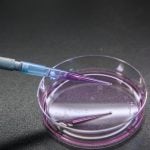Flax producers have two options when determining whether their crop contains marketable levels of fibre.
The “quick and dirty” method, says Alvin Ulrich of
Biolin Research Inc., is to twist a handful, much the way hay and grain in the swath is tested for moisture content before harvesting.
To do this, take 10 to 15 stems about a foot long, grab the ends with both hands and jerk the bundle back and forth.
Most of the stems will break if the fibre content is low.
Read Also

VIDEO: Ag in Motion documentary launches second season
The second season of the the Western Producer’s documentary series about Ag in Motion launched Oct. 8.
However, if most of the strands remain intact and a good number of yanks from both ends only softens the main bundle, that means fibre content is high.
Ulrich said farmers who use this method should remember that humidity and rain may affect the results.
“If you did that on a wet day, the straw will always seem to be stronger. On a very dry day, it will always seem weaker,” he said. “It’s a very rough kind of thing.”
For more accurate results, he advised flax growers to have his company test their crop with its near infrared machine, which compares plant material to a large database of fibre test results that took five years to compile. The $100,000 device can take an accurate picture of fibre content in about six minutes.
“The machine shines a near infrared light into the sample and then analyzes the spectra that bounces back out. It then compares that against other samples that we’ve scanned and tested manually,” Ulrich said.
“The principle is the same as the system we use to measure protein in wheat.”
He said farmers shouldn’t assume that the fibre content of their oilseed flax straw is low.
“We’ve found that it’s not true,” he said.
“There is some very nice fibre in oilseed flax. But you can ruin the potential of the fibre in your harvest method or if it doesn’t ret.”
The best quality straw from oilseed flax can often be used for lower end textiles, insulation or plastic composites, he added.
European fibre varieties offer 50 percent more fibre yield, but grow only about six inches taller than their oilseed cousins in Canada. However, there is a clear tradeoff on seed yield, typically only 30 percent of the oil content of a common oilseed breed.
European farmers who target the fibre market seed at rates three times higher than for oilseeds and aim for more even distribution of plants per sq. foot to boost straw yields per acre.
Ulrich said for the organic grower, this strategy has the added benefit of making the crop more weed competitive.
However, it’s not enough to only increase the seeding rate. For example, using an air seeder set to plant heavier in rows 12 inches apart is the wrong approach.
“If I increase my seeding rate using that configuration, I just get really crowded plants in a row. A lot of the littler plants will die before harvest.”
Greater seedbed use might be possible using an old hoe drill. If the drill has a three inch spread and a shovel every seven to eight inches, that would give 40 percent use, he said.
An alternative would be to convert the air seeder to nine inch spacing and use Froc boots with 12 inch shovels.
Trials at the Prairie Agricultural Machinery Institute found these modifications made it possible to achieve 60 to 70 percent seedbed use, which allowed seeding rates to be increased to 80 to 90 pounds per acre from 40 lb.
A higher seeding rate with a wider spread offers higher seed and straw yields.
“That was another myth. People said that you either get seed or straw, but you can’t get more of both,” Ulrich said. “But in fact, if I spread my seed more and increase my seeding rate, I actually can get more seed and straw.”














